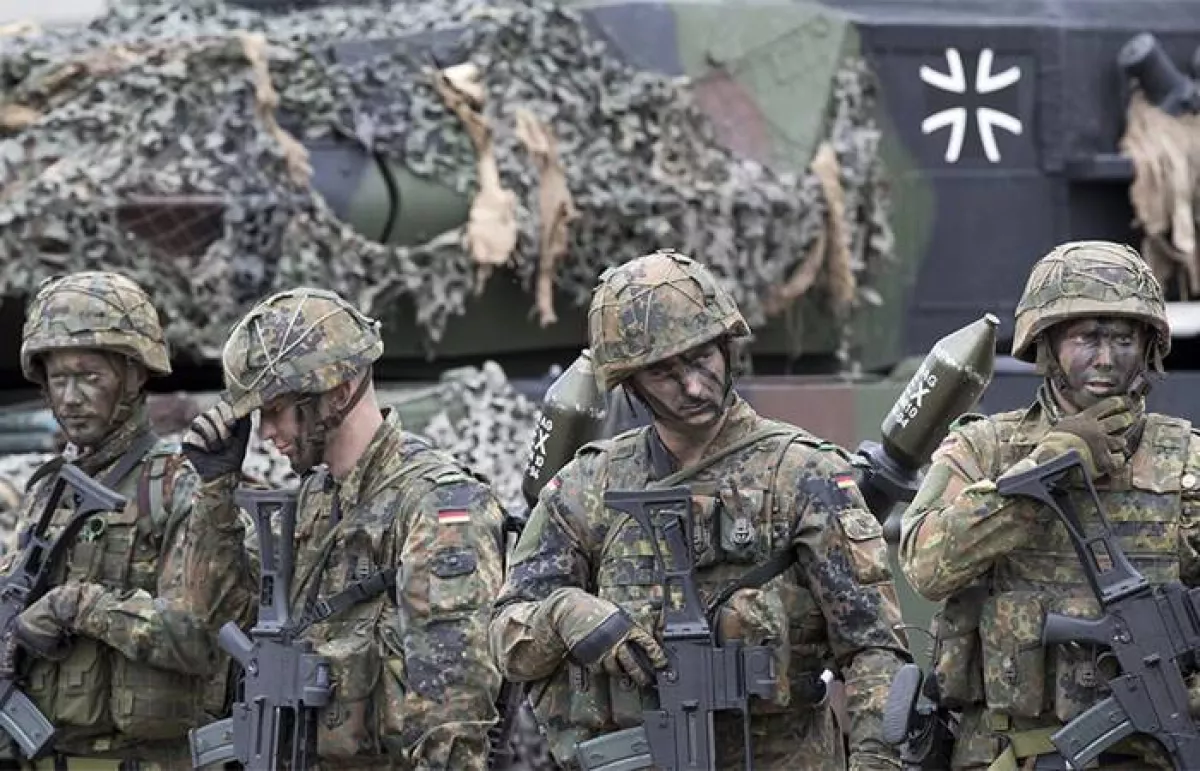Can Germany revive its military power? Ambitions, challenges, and reactions
If the German government succeeds with its ambitious military and defence-industrial plans, Europe could face seismic change. Yet turning these plans into reality will involve challenges that are exceedingly difficult to overcome.

Unusual—though long-anticipated—discussions are beginning to surface in EU political circles about Germany’s intentions to become the continent’s leading military and defence-industrial power. As Politico notes, “For decades, the European Union ran on an unspoken understanding: Germany handled the money, France handled the military.” Now, however, Berlin appears genuinely determined to alter this balance. At the very least, the coalition government of the Federal Republic of Germany, led by centre-right Chancellor Friedrich Merz, is declaring—and beginning to implement—precisely such ambitions.
Despite the fact that the German authorities’ intentions are still being discussed in hushed tones, this is undoubtedly a major strategic issue. If Germany’s plans succeed, the consequences for the military and political balance within the EU—as well as for the Union’s foreign and security policy—will be felt swiftly. Yet how likely is such success? And how will Europe, and the wider world, react?
Germany’s plans
It must be said from the outset that Germany has a long way to go before it can genuinely become Europe’s principal military power—one capable of projecting fear both across the continent and beyond. Despite its traditionally strong economy, the current state of the Bundeswehr, by the German government’s own assessment, can hardly be described as matching any significant military or political ambitions. This applies to its weapons systems, the readiness of its armed forces, and Berlin’s deep military and defence-industrial dependence on the United States.
Moreover, the political climate within Germany today is unlikely to support a swift or smooth implementation of these militarisation plans.
Firstly, economically, Germany no longer appears as the undisputed powerhouse that, for decades, ensured its rapid growth and served as a driver of the entire European economy. Today, all signs point to a systemic crisis in Germany’s economic model, affecting multiple foundational pillars at once. Sooner or later, Berlin will likely find a way out of this crisis—but how quickly remains uncertain. At the same time, betting on the military-industrial sector as an anti-crisis tool is understandable, yet it is not guaranteed to deliver the desired results. At a minimum, for this strategy to work, Berlin would need to secure orders for its defence industry beyond Germany’s borders. As we will show below, such prospects do not appear assured.
Secondly, Germany’s political stability seems to be slipping into the past. One would like to believe this is a temporary phenomenon, but in the near term, there are more reasons to expect further deterioration than a return to the familiar status quo.
Moreover, thirdly, Germany is clearly experiencing a crisis of identity. This is expressed not only in a re-evaluation of its place in European and global politics, but also—apparently—in the deeper layers of German society’s self-perception and collective consciousness. In recent years, both in business and in broader cultural life, it has become increasingly evident that even the famous German sense of order (Ordnung) is undergoing some form of transformation. According to the author’s modest observations, the country’s value-based, cultural, and political contradictions have intertwined into a knot that can confidently be described as the deepest identity crisis Germany has faced in the past fifty years.
In the context of these internal challenges—above all, the identity crisis—the military ambitions of Merz’s government are particularly interesting. These challenges do not necessarily mean that the Federal Republic of Germany will be unable to achieve at least some of its goals. However, they significantly complicate the path forward and generate additional, complex questions.

By 2029, Berlin plans to spend €153 billion on defence, roughly equivalent to 3.5% of GDP—meeting the NATO commitment for purely military expenditure agreed at this year’s Hague summit. An additional 1.5% of GDP is expected to be allocated to related spending. For comparison, France intends to allocate around €80 billion to defence by 2030, while Poland, which also aspires to military primacy in the EU, is unlikely to spend more than €50 billion per year.
It is therefore important to emphasise that, despite the economic crises noted within Germany itself, its economy remains in far better shape than, for example, France’s. This is particularly true given France’s very high levels of public debt and budget deficits, contrasted with Germany’s enviable capacity to secure extensive borrowing on favourable terms. Such comparisons lead many in the EU to conclude that Berlin’s military ambitions are serious and that “It’s the most important thing happening right now at EU level.”
In this context, Berlin has made a number of significant decisions in just the past few months. For example, in mid-March, the Bundestag eased constitutional limits on debt financing. The main purpose of this decision is to remove legislative barriers to a sharp increase in funding for the military and defence-industrial sectors. The Ministry of Defence has prepared a “wish list” outlining the Bundeswehr’s long-term needs across various armament programmes, with a total value exceeding €377 billion. Currently, contract proposals from this list worth €83 billion are being prepared for Bundestag approval by the end of 2026.
Debates have also intensified over the possible reinstatement of universal conscription. Supporters of such a move have not yet fully convinced their opponents. Last week, a compromise decision was adopted: all 18-year-old men will be required to register and undergo medical screening, providing the government with more precise information on the potential mobilisation pool. Political discussions on the possible introduction of mandatory service are expected to continue.
Reactions within the EU
Naturally, Germany’s military ambitions automatically revive old spectres across many parts of Europe. Although eight decades have passed since the end of World War II, many still find it difficult to separate the image of a militarised Germany from the European catastrophes of the 20th century.

At the same time, it cannot be said that the prospect of a Germany restored to military power alarms everyone in Europe or beyond. There are many prominent voices that, on the contrary, have long advocated for Berlin to convert its economic strength into military capability. Some of these voices argue that without Germany, neither France nor any other European country could turn the EU’s lofty declarations of military and defence-industrial autonomy into reality. Others maintain that a militarily strong Germany is critically important for establishing a stable military-political balance on the continent.
Even in countries that view such prospects positively, structural and other factors mean that there are realistically few ways to actively support the process.
One obvious political-economic issue, for example, is that in order for Germany’s defence industry to operate at full capacity, it needs substantial orders from outside its own borders. Without these, it would be unable to establish and sustain a significant production base. Over the long term, it would also struggle to offer competitive pricing for German weaponry and to guarantee uninterrupted service and maintenance. This reality makes Berlin a natural stakeholder in the concept of European strategic autonomy, which includes reducing dependence on external arms suppliers. Although, to date, German authorities have not shown unconditional commitment to this concept in practice, this has further exacerbated tensions between Berlin and Paris.
However, even if Germany now becomes the principal promoter of European strategic autonomy, to what extent will other continental states be willing to support its ambitions? How eager and able will they be to increase the hypothetical share of arms imports from Germany? The issue is not only about relations with the Federal Republic and the cautious perception of its military plans. An even more critical question concerns relations with the United States. Purchases of American defence systems by European states are valuable not merely for their intrinsic capabilities; they are also a key means of maintaining close political ties with Washington and a way to lobby for national interests in the U.S. capital.
Moreover, many European companies are deeply integrated into the production and logistical chains of the U.S. defence-industrial sector. This makes them stakeholders in the existing arrangements, even if, in theory, greater European strategic autonomy would offer them broader opportunities. As the saying goes, “a bird in the hand is worth two in the bush”—especially in times of extreme uncertainty, such as the present. This is compounded by the fact that Germany itself has not proposed concrete plans to “Europeanise” its military modernisation. On the contrary, it is resolutely protecting its domestic companies from competitors, and shielding its defence procurement system from any European Commission claims to a coordinating role across the EU.
Moreover, the vast majority of European NATO members—including Germany itself—have a strong interest in maintaining, even in a reduced form, the American military presence in Europe. Along with it comes at least a partial sense of security under the U.S. protective umbrella. To this end, they are likely to continue “holding on” to contracts with American arms manufacturers as a final-ditch argument to prevent a complete withdrawal of U.S. forces from Europe.
This issue also carries another delicate nuance. After the defeat of Nazi Germany, American military dominance in Europe was viewed as a guarantee that, even with a very strong economy, Germans would never re-emerge as a militarised nation—and would never again pose a threat to anyone on the European continent. The relevance of such fears, as noted above, is far lower today than it was a few decades ago. Nevertheless, it would be incorrect to entirely exclude them from the analysis.

This is particularly notable against the backdrop of a rightward shift in German politics, which could, at the next stage, lead to the far-right Alternative for Germany (AfD) entering the federal governing coalition. Today, the party is solidly in second place in national opinion polls and, according to some estimates, has already become Germany’s most popular political force.
More mainstream parties are being forced to adopt AfD policy positions and begin cooperating with it, despite the previously proclaimed “cordon sanitaire”—a refusal to collaborate under any circumstances, even on mutually beneficial issues. As a result, these walls are beginning to crumble in Germany (and at the broader European level) like house of cards. It is clear what emotions this stirs in other European countries and how it may affect their attitude towards Berlin’s military plans.
Reactions from the United States
Finally, perhaps the most important question is how Washington will view Germany’s military ambitions. It is obvious that the U.S. has extensive means to, if not derail, then at least significantly influence and adjust Berlin’s plans.

The United States is largely responsible for the declared and ongoing shifts in European military thinking, including in Germany—probably even more so than the perceived Russian threat. As data from the Stockholm International Peace Research Institute (SIPRI) show, while there were notable surges in demand for weapons among European NATO members after 2014 and 2022, Donald Trump’s return to the White House made the European militarisation agenda effectively irreversible. This trend is also evident in the chronology of key decisions in this area in the EU and Germany in 2025.
European politicians now frequently argue that the rhetoric and actions of the Trump administration have eroded their former trust in their main ally. Specifically, they question whether, in the event of a hypothetical conflict, the U.S. would fully honour its alliance obligations under Article 5 of the NATO Charter. More precisely, they are concerned with European interpretations of what this cornerstone article of collective defence actually entails, since there is no universally accepted reading. In reality, however, the problem appears to be far broader: it reflects increasingly divergent strategic interests between the U.S. and the EU.
In any case, the EU’s total dependence on the American security umbrella—and the desire to preserve it in as full a form as possible—automatically gives Washington enormous leverage and influence over all future plans for the development of Europe’s defence industry.
A real and substantial move by Germany along its declared path would mean a reduction in European arms purchases from the U.S. Although, of course, American manufacturers do not dominate the European market across the board. For example, European NATO members primarily source ships, submarines, tanks, armoured vehicles, and artillery systems from non-American suppliers. To some extent, therefore, Germany’s defence industry could expand deliveries across the continent without harming American competitors. But only to a limited degree. It is safe to assume, then, that both the defence-industrial lobby and the U.S. government are unlikely to be enthusiastic about Germany’s plans.








